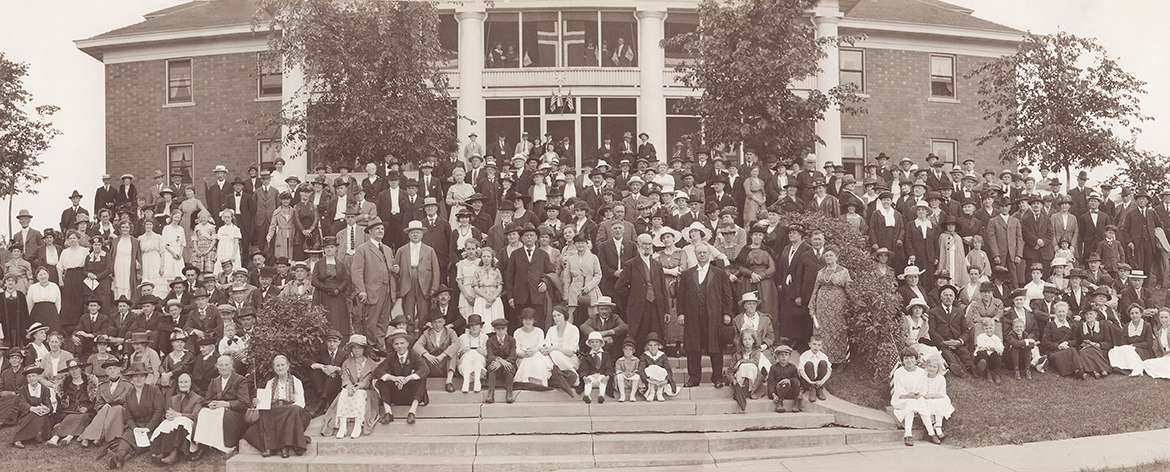From Books to Bricks
In 1903, Anna Quale Fergstad gathered together several Norwegian women to form a literary club. Near the end of that year, Mrs. Fergstad expressed her desire for the club to take up charitable work of some sort. Thinking of a vivid picture of the snug little huts along the coast of Norway that sheltered the wives of fishermen who had lost their lives at sea, she realized that, in America, there were many older people without family or friends to care for them. They were in need of some shelter and care. How splendid and useful an undertaking for their club to give at least a few of these deserving kinsfolk a home in which they could spend their last years.
The idea took form on October 19, 1903, when the group formed an organization, the Lyngblomsten Society, dedicated toward that goal. Mrs. Fergstad was named president. The group selected the name Lyngblomsten to commemorate the national flower of Norway, the lyng.
The organization began to grow by establishing "branches" around the Upper Midwest. On February 17, 1906, they incorporated and began fund raising. In 1911 they bought land midway between Minneapolis and St. Paul. In 1912 construction of the home began at Midway Parkway and Pascal Avenue. The home opened in December of that year with 34 older Norwegians moving in.
The home operated on the concept of residents helping with chores as they were able, and receiving help at the level each person needed—very similar to how our continuing care campus works today. It is important to note, then, that Lyngblomsten did not begin as a “nursing home,” but rather as “assisted living”—a term that didn’t exist until decades later.
The Winds of Change
For several decades, the women, their daughters and granddaughters ran the Lyngblomsten Home through the sponsorship of member branches. But as women entered the workforce and had less time for volunteer work, along with increasing government regulations for board and care being established, it was no longer a feasible method.
In 1960, Lyngblomsten was reincorporated and its grounds and assets were gifted to what was then the St. Paul Conference of the American Lutheran Church. The members of the Board of Directors began coming from the churches (instead of from the branches) and staff were hired to handle the day-to-day operations. The branches were transitioned into the new Lyngblomsten Auxiliary.
Today Lyngblomsten is affiliated with the Evangelical Lutheran Church in America (ELCA) and partnered in ministry with Twin Cities-area Christian churches. Lyngblomsten welcomes older adults of all faiths and nationalities.
Growing & Changing
In the early 1960s, the skilled nursing facility was added (a requirement given by the churches as a condition of forming the partnership). The next decade saw the addition of the Lyngblomsten Apartments and the Lyngblomsten Community Senior Center (which today is part of our Lyngblomsten Community Services). With heavy hearts, in 1993 the original building that housed the Lyngblomsten Home for the Aged was demolished to make way for the Heritage Apartments (market rate).
In the 1990s, Lyngblomsten began developing community outreach programs (such as Parish Nurse Ministry) and work began on adopting the Swedish model of care, known as “service houses,” in the care center. The service-house model would be modified a decade later, ushering in the neighborhood model of person-centered care.
In the early 2000s, major fundraising made way for the massive remodeling of the care center, readying the facility for “neighborhoods” and person-centered care. The shift in how care was provided took several years to fully integrate, but as an early adopter and embracing our call to innovation, Lyngblomsten soon became known as a leader in the Culture Change movement—the terminology used to describe a new era in skilled nursing care.
In 2005, our first transitional care unit opened, serving those who needed a place to recuperate between hospital and home. On the community side, our outreach programs were expanded to help support the growing number of older adults, including the launch of The Gathering. In 2006, with much fanfare, Lyngblomsten celebrated the 100th anniversary of its incorporation.



